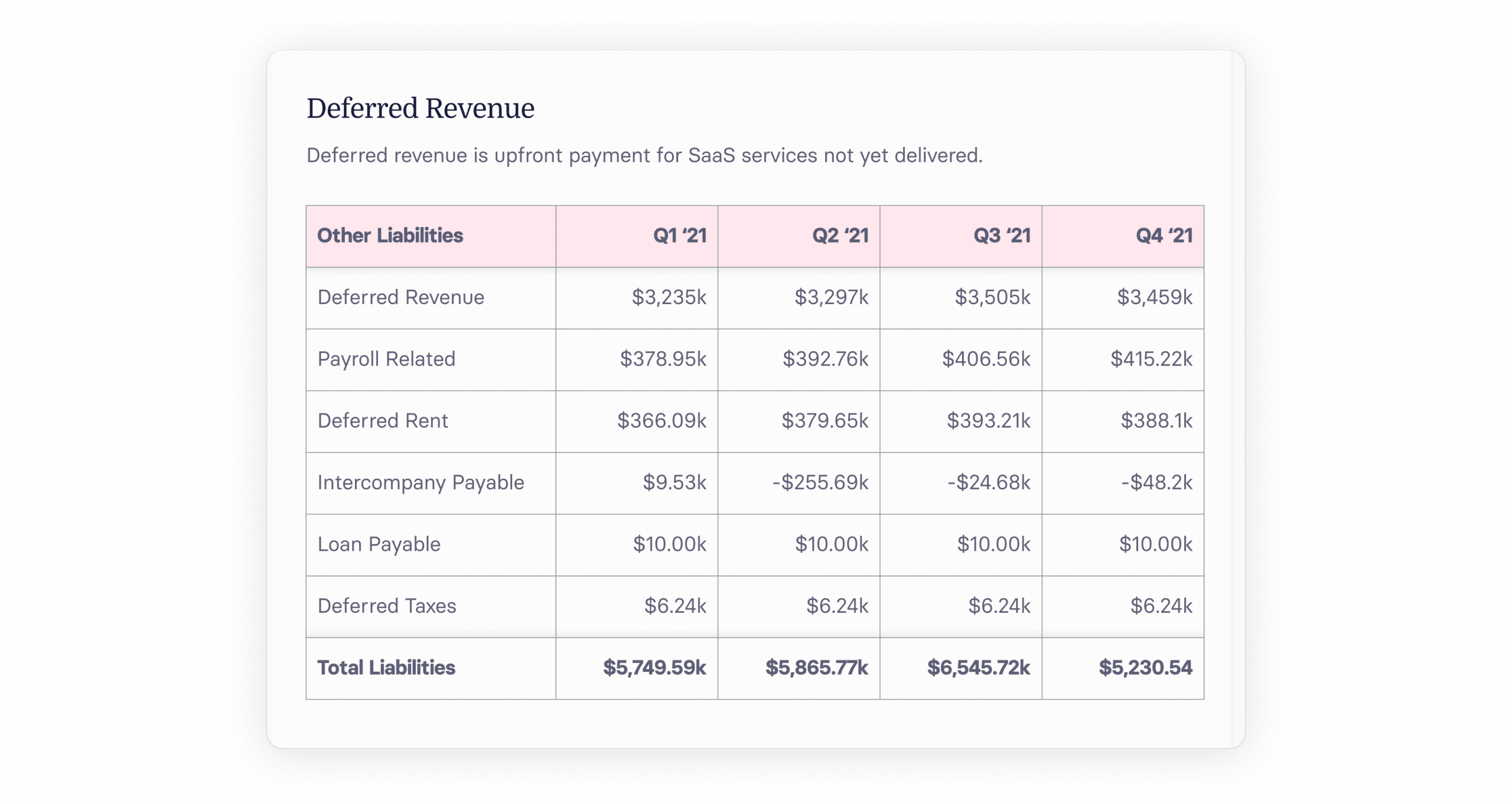Deferred revenue, a key concept in SaaS, represents prepayments from customers for future services, recorded as a liability until the service is delivered.
What is deferred revenue?
Deferred revenue—also known as unearned revenue—is payment received for products or services that haven’t yet been delivered. In SaaS, this often means customers pay upfront for a subscription that spans a set period: monthly, quarterly, semiannually, or annually.
According to standard accounting principles, revenue should only be recognized once the service is provided—not when the payment comes in. Until then, that payment is recorded on the balance sheet as deferred revenue. As services are delivered each month, a portion of the payment is recognized as revenue.
<<Download the SaaS metrics cheat sheet.>>

In finance, an obligation to deliver a product or service in the future is treated as a liability—just like any other form of debt. For SaaS businesses, subscriptions are used over time, meaning the full payment isn’t “earned” right away. The portion that covers future services gets recorded as deferred revenue until it’s fully delivered.
Deferred revenue can also be a valuable signal. It offers a forward-looking view into your company’s potential performance. During the month-end close, deferred revenue gives you a snapshot of what’s ahead. For instance, if it’s trending upward month over month, that could point to steady growth on the horizon.
On the flip side, if deferred revenue is shrinking, it may be a sign that customers aren’t renewing. Tracking these trends early can help you get ahead of churn, adjust your strategy, and protect your cash flow.
The importance of deferred revenue for SaaS businesses
Accurately tracking deferred (or unearned) revenue can help your SaaS business:
- Get a clear view of financial obligations and a more accurate picture of overall fiscal health
- Forecast future cash flow and spot trends in renewals and customer churn
- Show the strength of long-term customer relationships—key for building investor confidence
- Manage liabilities by understanding your delivery commitments and avoiding overcommitting or overspending
- Gain deeper insight into net income
While ASC 606 adds complexity to how deferred revenue is recorded, having this data on hand can elevate your financial analysis and modeling—ultimately helping you make smarter, more strategic decisions.
Key takeaways
- Deferred revenue, a key concept in SaaS, represents prepayments from customers for future services, recorded as a liability until the service is delivered
- Accurately tracking deferred revenue offers insights into financial health, aiding in cash flow forecasting and investor confidence
- SaaS businesses benefit from understanding deferred revenue to optimize renewal strategies and manage customer churn
- Adhering to GAAP principles, deferred revenue shifts to earned revenue as services are rendered, providing a realistic view of income over time
Recommended For Further Reading
How to record and account for deferred revenue
In accrual accounting (unlike cash basis accounting), payments and expenses are credited, while earned income is debited. On the balance sheet, deferred revenue is recorded as a liability—not an asset—because it reflects your obligation to deliver services over time. Under generally accepted accounting principles (GAAP), you “owe” your customers until the full service period has been fulfilled.
Let’s break it down with a quick example to show the difference between standard revenue recognition and deferred revenue in a SaaS context.
Imagine a store that sells shoes. If it sells 100 pairs in January at $20 each, that’s $2,000 in revenue. Because the transaction is complete, the balance sheet might reflect:
- Current assets (accounts receivable): $2,000
- Current liabilities: $0 (there’s no ongoing obligation to the customer)
Now, compare that to a SaaS business where a customer pays $120 upfront for a one-year subscription. At the end of January—after one month of service—the balance sheet might look like this:
- Current assets (accounts receivable from upfront payment): $120
- Current liabilities (deferred revenue for 11 remaining months): $110
Only $10 of that $120 is earned revenue for January. The rest is deferred until the services are delivered in future months.
Since the company has only delivered one month of service in January, just $10 of the $120 subscription is recognized as revenue. The remaining $110 is still considered deferred and listed under current liabilities—not long-term—since it typically gets earned within a year.
Things get a bit more complex under ASC 606 and the revenue recognition principle. Even if you sell annual contracts, you can’t always just divide the total evenly across 12 months. For instance, if setup fees are itemized in the contract, they may need to be recognized upfront.
Following GAAP guidelines for recording deferred revenue helps paint a clearer, more accurate picture of your company’s financial health. But it’s only one side of the story. Accrual accounting also requires that expenses be recorded when they’re incurred—not when the cash changes hands—so your financials reflect the true state of your business.
Deferred revenue examples
Here’s a simple example of how deferred revenue works:
If a customer pays $1,200 upfront for a one-year SaaS subscription in January, none of that revenue is “earned” on day one. Assuming the subscription covers a single product at a flat monthly rate, you would recognize $100 in revenue at the end of January. The remaining $1,100 stays on the balance sheet as deferred revenue. Each month, another $100 shifts from deferred to earned until the full amount is recognized by year-end.
Now let’s walk through a more detailed example:
Say a customer signs a one-year contract starting January 1. You charge a $100 setup fee and $100 per month for your product—normally totaling $1,300 for the year. Because the customer pays annually upfront, you offer a 10 percent discount, bringing the total to $1,170.
By the end of January, you would recognize $180 in revenue ($100 setup fee + $80 for the first month, after discount). That leaves $990 in deferred revenue for the remaining service months. Without the discount, you would have recognized $200 in January, but revenue recognition must reflect the total discounted amount.
<<Get the bookings to revenue waterfall template.>>
Deferred revenue FAQs
Is deferred revenue a liability or an asset?
Deferred revenue is recorded as a liability on the balance sheet. Because the business still owes services to the customer, that revenue hasn’t been “earned” yet. As the subscription is fulfilled each month, a portion of the deferred revenue is recognized and moved from liabilities to earned revenue—reflecting the delivery of the service over time.
What is the difference between deferred revenue and accrued revenue?
Deferred and accrued revenue are two sides of the same coin—both deal with timing differences in how revenue is recognized.
Deferred revenue
This occurs when a customer pays in advance for services that haven’t been delivered yet. Because the income hasn’t been earned, it’s recorded as deferred revenue (a liability). As services are delivered, the amount is gradually recognized as revenue.
Accrued revenue
Accrued revenue happens when you’ve provided a service or delivered a product, but haven’t received payment yet. It’s recorded as revenue earned but not yet billed—and gets balanced once the payment comes in.
In short:
- Deferred revenue = Payment first, service later
- Accrued revenue = Service first, payment later
What is the opposite of deferred revenue?
Accrued revenue is the opposite of deferred revenue. While deferred revenue reflects payments received before services are delivered, accrued revenue refers to income earned for services already provided—but not yet paid for.
How do you record deferred revenue?
Deferred revenue is generally recorded under current liabilities in the company’s balance sheet.

